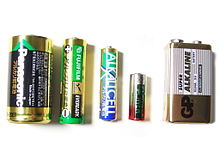
Back بطارية قلوية Arabic Алкална батерия Bulgarian Pila alcalina Catalan Alkalický článek Czech Alkali-Mangan-Zelle German Pila alcalina Spanish Leeliselement Estonian باتری قلیایی Persian Alkaliparisto Finnish Pile alcaline French
 | |
| Self-discharge rate | <0.3%/month |
|---|---|
| Time durability | 5–10 years |
| Nominal cell voltage | 1.5 V |
An alkaline battery (IEC code: L) is a type of primary battery where the electrolyte (most commonly potassium hydroxide) has a pH value above 7. Typically these batteries derive energy from the reaction between zinc metal and manganese dioxide.
Compared with zinc–carbon batteries of the Leclanché cell or zinc chloride types, alkaline batteries have a higher energy density and longer shelf life, yet provide the same voltage.
The alkaline battery gets its name because it has an alkaline electrolyte of potassium hydroxide (KOH) instead of the acidic ammonium chloride (NH4Cl) or zinc chloride (ZnCl2) electrolyte of the zinc–carbon batteries. Other battery systems also use alkaline electrolytes, but they use different active materials for the electrodes.
Alkaline batteries account for 80% of manufactured batteries in the US and over 10 billion individual units produced worldwide. In Japan, alkaline batteries account for 46% of all primary battery sales. In Switzerland, alkaline batteries account for 68%, in the UK 60% and in the EU 47% of all battery sales including secondary types.[1][2][3][4][5] Alkaline batteries contain zinc (Zn) and manganese dioxide (MnO2) (Health codes 1), which is a cumulative neurotoxin and can be toxic in higher concentrations. However, compared to other battery types, the toxicity of alkaline batteries is moderate.[6]
Alkaline batteries are used in many household items such as Portable media players, digital cameras, toys, flashlights, and radios.
- ^ Olivetti, Elsa; Jeremy Gregory; Randolph Kirchain (February 2011). "Life Cycle Impacts of Alkaline Batteries with a Focus on End-of-Life - EBPA-EU" (PDF). Massachusetts Institute of Technology, Materials Systems Lab. p. 110. Archived from the original (PDF) on October 7, 2011. Retrieved July 29, 2014.
- ^ "BAJ Website - Monthly battery sales statistics". Battery Association of Japan. March 2011. Archived from the original on December 6, 2010. Retrieved July 29, 2014.
- ^ "Absatzzahlen 2008" (PDF) (in German). Interessenorganisation Batterieentsorgung. Archived from the original (PDF) on March 25, 2012. Retrieved July 29, 2014.
- ^ Fisher, Karen; Wallén, Erika; Laenen, Pieter Paul; Collins, Michael (October 18, 2006). "Battery Waste Management Life Cycle Assessment Final Report for Publication" (PDF). Environmental Resources Management, DEFRA. p. 230. Archived from the original (PDF) on October 8, 2013. Retrieved July 29, 2014.
- ^ "EPBA Battery Statistics - 2000". European Portable Battery Association. 2000. Archived from the original on March 21, 2012. Retrieved July 29, 2014.
- ^ Health Effects. Agency for Toxic Substances and Disease Registry (US). September 2012.